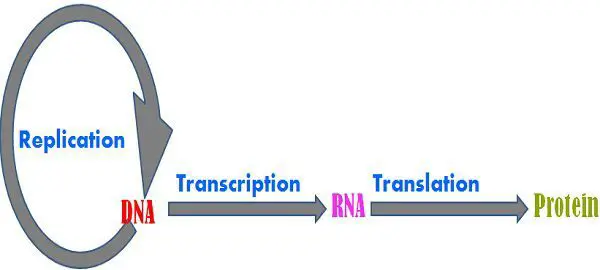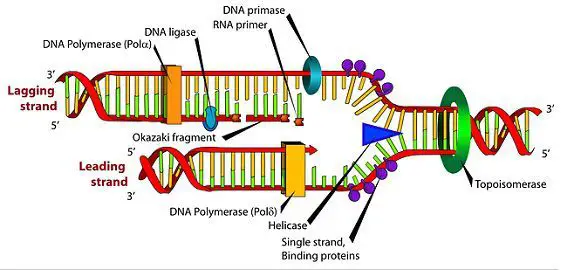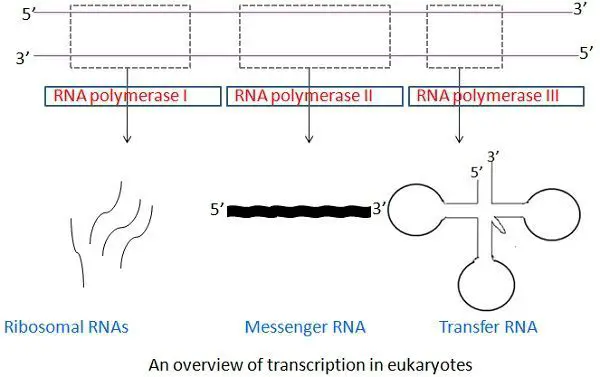Replication is processed inside the nucleus and involves the copying of the genetic material so that the new daughter cell thus form contains the identical copies as their parent cells. While transcription is processed in the cytoplasm where a segment of DNA is transcribed into RNA. Both the process occurs inside the cell.
The flow of biological information from DNA to RNA and then synthesis of proteins is considered as the ‘central dogma of life‘. These involve the three main processes which are replication, transcription, and translation. Replication is the process of duplicating the ones own genetic materials into two more identical copies, so that the similar information may get further transfer to the new daughter cells.
Transcription involves the conversion of DNA into RNA, it is helpful in gene expression of the selected segment of DNA. Translation is said as the final step where protein formation takes place. Below we will be discussing the important difference between replication and transcription, and the process involved in it.
Content: Replication Vs Transcription
Comparison Chart
| Basis for Comparison | Replication | Transcription |
|---|---|---|
| Definition | Replication is the duplication of strands of Deoxyribonucleic acids (DNA), which gives two daughter strands and each strand contains half of the original DNA. | Transcription is the formation of only single identical Ribonucleic acid (RNA) from the double stranded DNA, which means transcription is the process after replication. |
| Principle | The main function of replication is to maintain the entire set of the genome for the next generation. | The main function of transcription is to make RNA copies of one's genes and here the genes are expressed of the replicated DNA. |
| In which phase it occurs | It occurs in the S phase of cell cycle. | It occurs in G1 and G2 phases of cell cycle. |
| Enzymes involved | DNA helicase, DNA polymerase enzymes, gyrase (eukaryotes). | RNA polymerase, Transcriptase. |
| It comprises | The unwinding and splitting of the entire DNA molecule (chromosome). | The unwinding and splitting of those genes only, which are to be transcribed. |
| Also copying of the entire genome. | Copying of few selected genes only. | |
| There is a hydrogen bonding between the replicated DNA strand and template strand. | Transcribed RNA strands gets separate from its DNA template strand. | |
| Products do not degrade after their function. | Products gets degraded after their function get complete. |
|
| The site of process | Product remains in the nucleus. | Product move from the nucleus to the cytoplasm. |
| Primer requirement | Requires RNA primer. | No primer required. |
| Material required | Deoxyribonucleoside triphosphate like dATP, dTTP, dCTP, dGTP serves as raw material. | Ribonucleoside triphosphate like ATP, CTP, GTP, UTP serve as raw materials. |
| Final Result | It results in the formation of two double-stranded DNA molecule from one DNA molecule and thus giving rise to the two new identical daughter cells. | It results in the formation of RNA molecule from a section of one strand which includes tRNA, rRNA, mRNA and non-coding RNA (like microRNA). |
Definition of Replication
DNA is a macromolecule, which carries genetic information from one generation to next generations. DNA can be regarded as reserve bank of genetic information. It is responsible for preserving the identity of the species over several years.
In the process of cell division, when the cell divides into two identical daughter cell, it also transfers the genetic information from the parent cell. So we can say that replication is a process where DNA copies itself and produces identical daughter molecules of DNA.
The process of replication is different in prokaryotes and in eukaryotes. Though it involves the few common steps like the origin of replication, it is the site from where the replication begins, at this site the enzyme gets attached and unwind the double helical structure into single and accessible form assisted by the enzyme DNA helicase.
The one strand is called leading (continuous or forward strand) strand while the another one is called lagging (discontinuous or retrograde) strand. This unwinding exposes the unpaired bases to serve as a template for the formation of new strands. The strand ends have their name as 5′ and 3′, and the process of replication starts from 5′ to 3′ directions, simultaneously on both the strands.
It is said that in prokaryotes synthesis of DNA is semi-discontinuous. The primer ( a small segment of RNA) is added, eventually proceeding to the addition of nucleotides, which are the complementary base pair with the unpaired base.
The enzyme called DNA polymerase helps in the formation of this assembly. Also, the pattern of replication in prokaryotes and in eukaryotes is same, that is the semi-conservative type, where half of the original DNA is conserved and the other is newly formed DNA. This evidence for semi-conservative DNA replication was given by Meselson and Stahl (1958).
Now the difference between the process of the two is due to the complexity of the cells where eukaryotes are more complex and hence they have multiple origins of replication, while prokaryotes have a single origin of replication. Also, replication is unidirectional in eukaryotes, which is bi-directional in prokaryotes.
Enzymes like DNA polymerase are only two in number in prokaryotes, while in eukaryotes it is four to five like (α, β,γ, δ, ε). The rate of replication is much faster in prokaryotes than eukaryotes. The DNA in prokaryotes is circular and don’t have ends to synthesize. The process of short replication in prokaryotes goes on continuously, whereas the DNA replication of the eukaryotes gets completes in S-phase of the cell cycle.
The process is carried out with high fidelity, so that the genetic information may get transfer correctly from one generation to generation. Proofreading activity is also done by DNA polymerase III, which checks the attachment of the nucleotides to the correct base pair. DNA polymerase corrects the mistakes of any mismatch found between the base pairing of the complementary bases.
Definition of Transcription
The intermediate product of DNA is RNA, where the genes are expressed after the replication. So it is called the site of expression of the genetic information. In this process, one of the two strands formed after replication works as a template (noncoding strand or sense strand) and another as antisense (coding strand or antisense strand). The almost whole process is same in both prokaryotes as well as in eukaryotes, but there exist some basic differences between them.
The whole molecule of DNA is not expressed in transcription, rather some selected part of DNA is only synthesized as RNA. The reason for this is unknown, but it is said that it might be due to the internal signaling.
The product formed in transcription is referred to as primary transcript, as these are inactive. So to make them functionally active they undergo certain kind of alterations like splicing, base modifications, terminal additions, etc. These are known as post – transcriptional modifications.
Some of the similarities between the prokaryotes and eukaryotes transcription process are like in both the kind DNA act as the template for the process, chemical composition (base pairs) is same, RNA polymerase plays a major role in both the groups.
While the difference lies in the process, which is simple in prokaryotes and it is much complexed in eukaryotes. In prokaryotes, only one type of RNA polymerase produces all three types of RNA (mRNA, tRNA, rRNA), while in eukaryotes different types of RNA produces different types of RNA-like type I produces rRNA, type II is mRNA and type III for tRNA and 5S rRNA.
Apart from this, there are other differences like in initiation site, Rho factor, promoter region, termination point, the presence of introns, post-transcriptional modifications, etc.
Though in many viruses, the genetic material is contained by RNA also and has the ability to perform other cellular function like DNA. But it is chemically found that DNA is more stable than RNA, hence DNA is only preferred as more suitable macromolecule for the storing the genetic information long life.
Key Differences Between Replication and Transcription
- Replication is the duplication of strands of Deoxyribonucleic acids (DNA), which gives two daughter strands and each strand contains half of the original DNA double helix; Transcription is the formation of only single identical Ribonucleic acid (RNA) from the double stranded DNA, which means transcription is the process of replication.
- The principle function of replication is to maintain and send the copy of the entire set of the genome for the next generation; While transcription work is to make RNA copies and where the genes are expressed of the replicated DNA.
- Replication occurs in the S phase of cell cycle while Transcription occurs in G1 and G2 phases of cell cycle.
- Enzymes involved in replication are DNA helicase, DNA polymerase, gyrase (in eukaryotes) and in transcription RNA polymerase, Transcriptase plays a major role.
- The process of replication and transcription comprises:
- The unwinding and splitting of the entire DNA molecule (chromosome) whereas transcription involves the unwinding and splitting of those genes only, which are to be transcribed.
- The process engages in the copying of the entire genome whereas transcription is copying of few selected genes only.
- There is a hydrogen bonding between the replicated DNA strand and template strand, while transcribed RNA strands get separate from its DNA template strand.
- Products do not degrade after their function, but in transcription process products gets degraded after their function gets complete.
- The site of the process of replication remains in the nucleus, but during the process, product move from the nucleus to the cytoplasm.
- Requires RNA primer in the replication process, there is no requirement of primer
- Deoxyribonucleoside triphosphate like dATP, dTTP, dCTP, dGTP serve as raw material in replication, Ribonucleoside triphosphate like ATP, CTP, GTP, UTP serve as raw materials in transcription.
- Replication results in the formation of two double-stranded DNA molecule from one DNA molecule and thus giving rise to the two new identical daughter cells while transcription results in the formation of RNA molecule from a section of one strand which includes tRNA, rRNA, mRNA and non-coding RNA (like microRNA).
Conclusion
From the above article, we can say that cell division is a vital and essential process for all the living beings to grow. Prior to cell division involves the most important process called as replication of the DNA. In this process, the genetic material gets divides and is ready to transfer it further to the new daughter cells.
While transcription involves the formation of RNA. This two process involves the enzymes like helicase, DNA polymerase, RNA polymerase, primase, transcriptase.So precisely we can say that DNA makes RNA and RNA make protein, which is the central dogma of all kinds of life.





Leave a Reply